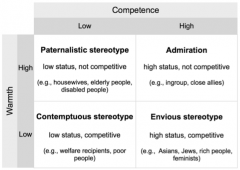![]()
![]()
![]()
Use LEFT and RIGHT arrow keys to navigate between flashcards;
Use UP and DOWN arrow keys to flip the card;
H to show hint;
A reads text to speech;
17 Cards in this Set
- Front
- Back
|
Stereotypes
|
Beliefs that all members of a particular group have the same qualities, which circumscribe the group and differentiate it from other groups.
The images that spring to mind once a particular category is evoked. |
|
|
Why Do Stereotypes Survive?
|
1. Kernel of Truth
2. Legitimising Function 3. Socialisation 4. Media 5. Sub-Typing 6. Attributions 7. Cognitive Factors: Assimilation and Accentuation 8. Cognitive Factors: Stereotypes as Expectancies |
|
|
Kernel of Truth
|
Are stereotypes based on some element of truth? This is feasible due to function of some aspect of social reality i.e.,
- Biological Differences - Status Differences - History - Desire for intergroup distinctiveness - Socialisation/Social Roles - Culture |
|
|
Kernel of Truth Limitations
|
- Are we really that clever?
- A lot of non-true stereotypical traits - Correlation between stereotype and reality was .04 (Terraciano et al., 2005) |
|
|
Legitimising Function Myths
|
- Groups with high status/power hold stereotypes that serve to rationalise and reinforce the outgroup's lower status/power.
- If men are meant to be hunter gatherers, should they not be adventurous, aggressive, courageous etc.; Women meant to be carers of the young, should they not be affectionate, gentle, patient etc. - Groups with low status/power might also manufacture stereotypes that help rationalise their position and to protect self-esteem |
|
|
Stereotype Content Model
|

Stereotype Content Model
|
|
|
Socialisation
|
Once the content of a stereotype has been established, the stereotype might survive through socialisation and learning. From brith, people are treated differently depending on whether they are guys or girls. e.g., socialising with male infant = more physical
|
|
|
Media
|
In the last 25 years there has been a conscious effort to reverse the stereotyped images of minority groups in TV and film, but stereotypes remain. But why:
- Laziness? - Do people have an affection for stereotypes (simple, familiar, sometimes funny) - Perpetuated unconsciously (e.g. pictures show more full body shots of women = more important for beauty than intellect) - Faceism |
|
|
Faceism
|
Face/head associated with intelligence, cuteness and ambition/dominance (Cartoon childrens books depict members of ethnic minorities with smaller heads)
|
|
|
Stereotype Inconsistent Information
|
- Possibility that over time, the stereotype will change to adjust to reality (book-keeping)
- If counter-stereotypical information is dramatic enough, it might even cause a sudden chane in attitudes (conversion) - Cognitive strategies that sometimes means stereotypes survive: Subtyping and Attributions |
|
|
Sub-Typing
|
Sometimes, stereotype-inconsistent information produces a sub-type, so that the outgroup stereotype becomes more complex but the stereotype of the superordinate group remains unchanged (e.g., sensitive new age guy, career woman)
|
|
|
Attributions
|
Attributing outcomes with external factors e.g. identifying tyre jack, females/males, luck/skill
|
|
|
Categorisation Cognitive Factors of Stereotyping
|
- Accentuation: In which intergroup differences are exaggerated
- Assimilation: In which intragroup differences are minimised |
|
|
Outgroup Homogeneity Effect
|
Outgroup members are viewed to be more homogenous and less differentiated than ingroup members.
Explanations: - Familiarity (more interactions with ingroup than outgroup). Does have some reverse explanations as well though - Abstractness (Ingroup seen as more variable because the conception of the category is important [we are in it], more concrete [we know someone else in it] and more provisional [we're motivated to have accurate appraisals of those close to us]) |
|
|
Stereotypes as Expectancies
|
People begin to view behaviour through the lens of the stereotype. Neutral or disconfirming information is then perceived as confirming information. Can be negative as well as positive (e.g. police officers dilemma).
Some stereotypes don't create certainty but rather hypotheses about the stereotyped individual. |
|
|
Self-Stereotyping
|
People even self-stereotype themselves based on salient group memberships
|
|
|
Can Stereotypes be Stopped?
|
Macrae et al. (1994): Pictures of skin-head, asked to write essay describing typical day in the life of skin- head. Half told to explicitly avoid stereotyping (suppressed condition). Then given another skin-head photo and asked to write another essay (no instructions). Second essay showed more stereotypical comments for the suppressed than control ("Rebound Effect")
|

